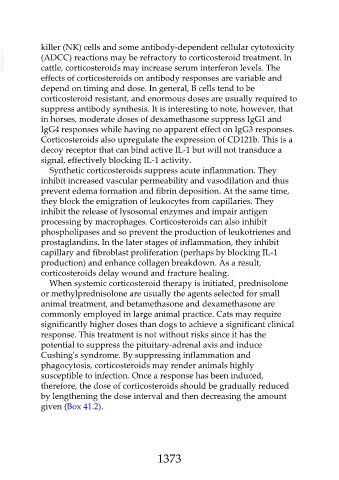Page 1373 - Veterinary Immunology, 10th Edition
P. 1373
killer (NK) cells and some antibody-dependent cellular cytotoxicity
VetBooks.ir (ADCC) reactions may be refractory to corticosteroid treatment. In
cattle, corticosteroids may increase serum interferon levels. The
effects of corticosteroids on antibody responses are variable and
depend on timing and dose. In general, B cells tend to be
corticosteroid resistant, and enormous doses are usually required to
suppress antibody synthesis. It is interesting to note, however, that
in horses, moderate doses of dexamethasone suppress IgG1 and
IgG4 responses while having no apparent effect on IgG3 responses.
Corticosteroids also upregulate the expression of CD121b. This is a
decoy receptor that can bind active IL-1 but will not transduce a
signal, effectively blocking IL-1 activity.
Synthetic corticosteroids suppress acute inflammation. They
inhibit increased vascular permeability and vasodilation and thus
prevent edema formation and fibrin deposition. At the same time,
they block the emigration of leukocytes from capillaries. They
inhibit the release of lysosomal enzymes and impair antigen
processing by macrophages. Corticosteroids can also inhibit
phospholipases and so prevent the production of leukotrienes and
prostaglandins. In the later stages of inflammation, they inhibit
capillary and fibroblast proliferation (perhaps by blocking IL-1
production) and enhance collagen breakdown. As a result,
corticosteroids delay wound and fracture healing.
When systemic corticosteroid therapy is initiated, prednisolone
or methylprednisolone are usually the agents selected for small
animal treatment, and betamethasone and dexamethasone are
commonly employed in large animal practice. Cats may require
significantly higher doses than dogs to achieve a significant clinical
response. This treatment is not without risks since it has the
potential to suppress the pituitary-adrenal axis and induce
Cushing's syndrome. By suppressing inflammation and
phagocytosis, corticosteroids may render animals highly
susceptible to infection. Once a response has been induced,
therefore, the dose of corticosteroids should be gradually reduced
by lengthening the dose interval and then decreasing the amount
given (Box 41.2).
1373

